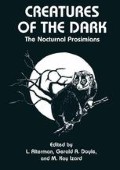Abstract
An oral tradition exists in Indonesia that the slow loris or coucang, Nycticebus coucang, is venomous (personal observation, also see Wilde, 1972). Few mammals are known to produce toxic compounds, and none is known to routinely use these toxins in allospecific defenses. Yet inhabitants of Kalimantan insist that the coucang protects itself from humans by using its toxic bite. Over the years there have been many accounts of bite-induced shock and prolonged edema of appendages which have been bitten, but the literature is devoid of reports identifying the source of putative toxins. If slow lorises do produce toxins which are used in defense against allospecifics then three sorts of questions might be asked. The most obvious questions are descriptive in nature. What tissue(s) is (are) the source of this venom? What is the chemical nature of putative toxins?
Access this chapter
Tax calculation will be finalised at checkout
Purchases are for personal use only
Preview
Unable to display preview. Download preview PDF.
Literature Cited
Alterman, L. & Hale, M. E. (1991) Comparison of toxins from brachial gland exudates of Nycticebus coucang and N. pygmaeus. American Journal of Physical Anthropology, Sup. 12, 43.
Barrett, E. (1981) The present distribution and status of the slow loris in peninsular Malaysia. Malaysia Applied Biology, 10, 205–211.
Barthalamus, G. T. & Zielinski, W. J. (1988) Xenopus skin mucus induces oral dyskinesias that promote escape from snakes. Pharmacology, Biochemistry & Behavior, 30, 957–959.
Cartmill, M. (1972) Arboreal adaptations and the origin of the order primates. In R. Tuttle (Ed.) The Functional and Evolutionary Biology of Primates (97–122), Chicago: Aldine Atherton Inc.
Charles-Dominique, P. (1977) Ecology & Behaviour of Nocturnal Primates. New York, Columbia University Press.
Griffiths, M. (1978) The biology of the monotremes. New York: Academic Press.
Manley, G. H. (1974) Functions of the external genital glands of Perodicticus and Arctocebus. In G. A. Doyle, R. D. Martin & A. C. Walker (Eds.) Prosimian Biology (313–329) London: Duckworth Press.
Michelsen, A. (1978) Sound reception in different environments. In M. A. Ali (Ed.) Sensory ecology: Review and perspectives (345–373) New York: Plenum Press.
Minton, S. A. (1990) Venomous bites by nonvenomous snakes: an annotated bibliography of colubrid envenomation. Journal of Wilderness Medicine, 1, 119–127.
Pearson, O. P. (1956) A toxic substance from the salivary glands of a mammal (short-tailed shrew). In E. E. Buckley & N. Porges (Eds.) Venoms (55–58), Washington, American Association for the Advancement of Science.
Pournelle, G. H. (1968) Classification, biology and description of the venom apparatus of insectivores of the genera Solendon, Neomys, and Blarina. In W. Bücherl, E. E. Buckley, & V. Deuloffeu (Eds.) Venomous animals and their venoms (31–42) New York: Academic Press.
Pucek, M. (1968) Chemistry and pharmacology of insectivore venoms. In W. Bücherl, E. E. Buckley, & V. Deuloffeu (Eds.) Venomous animals and their venoms (43–50) New York: Academic Press.
Rosenberger, A. L. & Strasser, E. (1985) Toothcomb origins: support for the grooming hypothesis. Primates, 26, 73–84.
Simons, E. L. & Rumpler, Y. (1988) Eulemur: New generic name for species of Lemur other than Lemur catta. (sic) Comptes Rendues Academie Scientifique Paris 307, 547–551.
Tidswell, F. (1906) Australian Venoms Sydney: Department of Public Health New South Wales.
Weldon, P. J. & Ferguson, M. W. J. (1993) Chemoreception in crocodilians: anatomy, natural history, and empirical results. Brain, Behavior and Evolution 41, 239–245.
Wilde, H. (1972) Anaphylactic shock following bite by a slow loris: Nycticebus cougang. The American Journal of Tropical Medicine and Hygiene. 21, 592–594.
Zielinski, W. J. & Barthalmus, G. T. (1989) African clawed frog skin compounds: Antipredatory effects on African and North American water snakes. Animal Behaviour, 38, 1083–1085.
Zimmermann, E. (1985) Vocalizations and associated behaviours in adult slow loris (Nycticebus coucang). Folia Primatologica 44, 239–245.
Author information
Authors and Affiliations
Editor information
Editors and Affiliations
Rights and permissions
Copyright information
© 1995 Springer Science+Business Media New York
About this chapter
Cite this chapter
Alterman, L. (1995). Toxins and Toothcombs: Potential Allospecific Chemical Defenses in Nycticebus and Perodicticus . In: Alterman, L., Doyle, G.A., Izard, M.K. (eds) Creatures of the Dark. Springer, Boston, MA. https://doi.org/10.1007/978-1-4757-2405-9_24
Download citation
DOI: https://doi.org/10.1007/978-1-4757-2405-9_24
Publisher Name: Springer, Boston, MA
Print ISBN: 978-1-4419-3250-1
Online ISBN: 978-1-4757-2405-9
eBook Packages: Springer Book Archive

